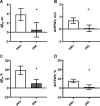Type 2 diabetes exacerbates changes in blood pressure-independent arterial stiffness: cross-sectional and longitudinal evidence from the SUMMIT study
- PMID: 37969084
- PMCID: PMC11208039
- DOI: 10.1152/japplphysiol.00283.2023
Type 2 diabetes exacerbates changes in blood pressure-independent arterial stiffness: cross-sectional and longitudinal evidence from the SUMMIT study
Abstract
Greater central artery stiffness is observed in people with type 2 diabetes (T2DM). Elevated blood pressure (BP) and altered arterial wall structure/composition in T2DM are generally considered as main drivers for this alteration. However, because conventional arterial stiffness measures are BP-dependent and as such an influence of BP remains in a measure, it is unclear if greater central artery stiffness is a function of greater BP, or due to changes in the structure and composition of the arterial wall. We aimed to measure BP-independent arterial stiffness (β0) cross-sectionally and longitudinally in T2DM. We studied 753 adults with T2DM (DM+) and 436 adults without (DM-) at baseline (Phase 1), and 310 DM+ and 210 DM- adults at 3-yr follow-up (Phase 2). We measured carotid-femoral pulse wave velocity and used it to calculate β0. In Phase 1, β0 was significantly greater in DM+ than DM- after adjusting for age and sex [27.5 (26.6-28.3) vs. 23.6 (22.4-24.8) au, P < 0.001]. Partial correlation analyses after controlling for age and sex showed that β0 was significantly associated with hemoglobin A1c (r = 0.15 P < 0.001) and heart rate [(HR): r = 0.23 P < 0.001)] in DM+. In Phase 2, percentage-change in β0 was significantly greater in DM+ than DM- [19.5 (14.9-24.0) vs. 5.0 (-0.6 to 10.6) %, P < 0.001] after adjusting for age, sex, and baseline β0. β0 was greater in DM+ than DM- and increased much more in DM+ than in DM- over 3 yr. This suggests that T2DM exacerbates BP-independent arterial stiffness and may have a complemental utility to existing arterial stiffness indices.NEW & NOTEWORTHY We demonstrate in this study a greater BP-independent arterial stiffness β0 in people with type 2 diabetes (T2DM) compared to those without, and also a greater change in β0 over 3 yr in people with T2DM than those without. These findings suggest that the intrinsic properties of the arterial wall may change in a different and more detrimental way in people with T2DM and likely represents accumulation of cardiovascular risk.
Keywords: aging; aorta; blood pressure; ultrasound.
Conflict of interest statement
No conflicts of interest, financial or otherwise, are declared by the authors.
Figures



References
-
- Strain WD, Chaturvedi N, Dockery F, Shiff R, Shore AC, Bulpitt CJ, Rajkumar C. Increased arterial stiffness in Europeans and African Caribbeans with type 2 diabetes cannot be accounted for by conventional cardiovascular risk factors. Am J Hypertens 19: 889–896, 2006. doi:10.1016/j.amjhyper.2006.01.009. - DOI - PubMed
MeSH terms
Grants and funding
LinkOut - more resources
Full Text Sources
Medical

